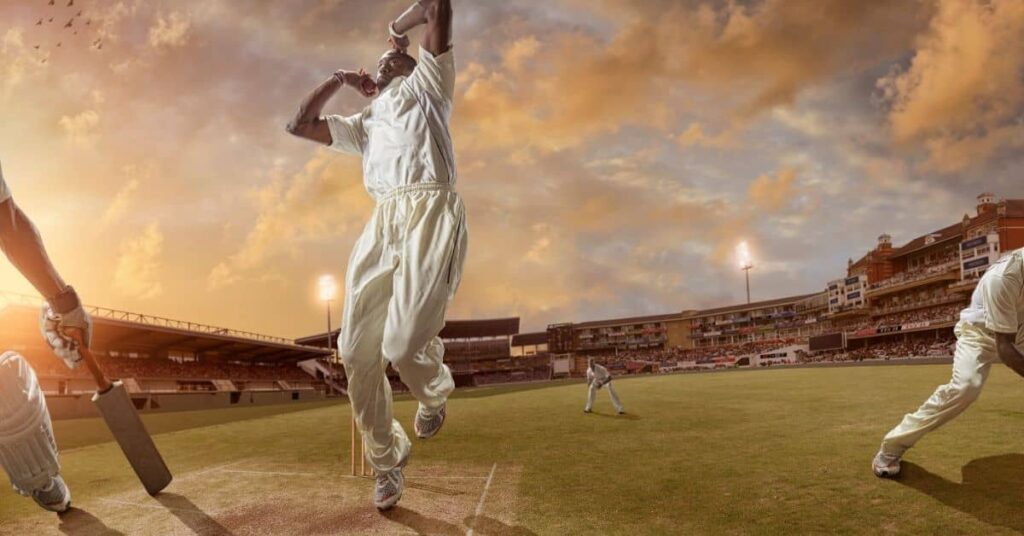I. Introduction
Cricket is more than just a sport—it’s a global phenomenon that unites millions across continents. Among the many benefits of playing cricket are improved fitness, sharper reflexes, and stronger teamwork skills. Whether you’re watching a nail-biting T20 match or playing a friendly game in your neighbourhood, cricket offers a unique blend of strategy, athleticism, and camaraderie.
In this article, we’ll explore the rich history of cricket, its rules and formats, the gear you need, and most importantly, the physical, mental, and social benefits of playing cricket.
II. History of Cricket 🏏
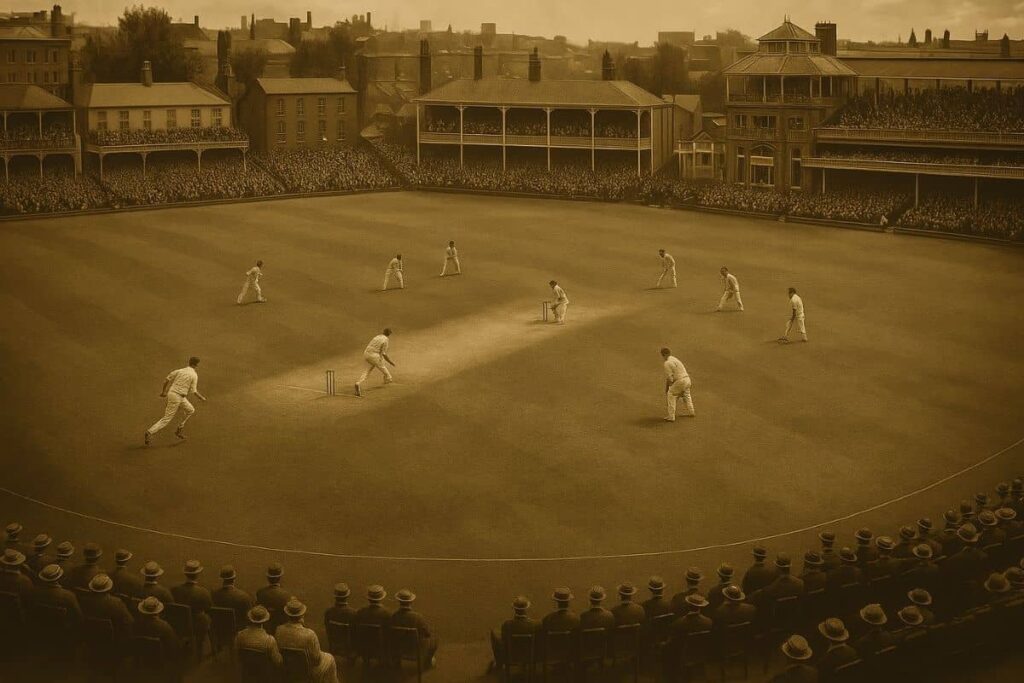
Cricket’s journey from a rustic pastime to a global sporting powerhouse is as fascinating as the game itself. Its evolution spans centuries, empires, and continents—shaped by tradition, colonialism, and innovation.
1. Origins in Rural England
Cricket is believed to have originated in the Weald region of southeast England during the late 16th century. Children in the counties of Kent and Sussex played a rudimentary bat-and-ball game in forest clearings and sheep-grazed pastures. The earliest known reference to the game dates back to 1597, when a court case in Guildford, Surrey, mentioned a game called “creckett” being played by schoolboys around 1550.
The name “cricket” may have derived from the Middle Dutch word krick (meaning stick) or the Old English cricc (meaning crutch or staff). Early versions of the game used simple tools: a lump of wool or wood as the ball, a stick or farm tool as the bat, and a stool or gate as the wicket.
📚 Learn more about cricket’s early days on Wikipedia’s History of Cricket page.
2. The 17th and 18th Centuries: From Pastime to Pastime of the Elite
By the early 1600s, cricket had gained popularity among adults. In 1611, two men were fined for playing cricket on a Sunday instead of attending church—a sign that the game was becoming more than just child’s play.
The 18th century marked a turning point. Cricket became a favourite among English aristocrats and gamblers. The Hambledon Club, founded in the 1760s, is often considered the cradle of modern cricket. It was during this period that the first formal rules were introduced, including the Leg Before Wicket (LBW) rule and standardized bat dimensions.
In 1787, the Marylebone Cricket Club (MCC) was established at Lord’s Cricket Ground in London. The MCC became the custodian of the Laws of Cricket, many of which still govern the game today.
3. The 19th Century: Cricket Goes Global
The 19th century saw cricket expand beyond England’s borders, largely due to the British Empire. British soldiers, merchants, and administrators introduced the game to colonies in India, Australia, the Caribbean, and Africa.
- The first international match was played in 1844 between the USA and Canada.
- In 1877, the first official Test match took place between England and Australia at the Melbourne Cricket Ground.
- The Ashes series, one of cricket’s most storied rivalries, began in 1882 after Australia defeated England at The Oval.
Cricket was not just a sport—it became a tool of cultural influence. In colonies like India, it was initially played by British elites, but soon local communities embraced and excelled at the game.
4. The 20th Century: Rise of the Modern Game
The 20th century witnessed the democratization and professionalization of cricket. Former colonies like India, Pakistan, and the West Indies emerged as cricketing powerhouses. The International Cricket Council (ICC) was formed to govern the sport globally.
Key milestones include:
- 1971: The first One Day International (ODI) was played.
- 1975: The inaugural Cricket World Cup was held in England.
- 2003: The T20 format was introduced, revolutionizing the game with its fast-paced, entertainment-driven style.
- 2008: The launch of the Indian Premier League (IPL) brought unprecedented commercialization and global viewership.
5. Cricket Today: A Global Phenomenon
Today, cricket is the second most-watched sport in the world, trailing only football. It thrives in diverse formats—from five-day Test matches to 90-minute T10 games. The game continues to evolve, with innovations in technology, broadcasting, and fan engagement.
Cricket’s enduring appeal lies in its ability to blend tradition with transformation—making it not just a sport, but a cultural force.
III. Understanding the Cricket Field

Cricket’s stage is as much a character in the drama as the players themselves. Below, we’ll unpack its dimensions, the central strip where every contest unfolds, and the art of placing fielders to shape victory.
1. Field Dimensions and Overall Layout
First and foremost, a cricket ground is almost always oval or circular, but it wears many shapes—from perfect circles to elongated ovals—so long as the perimeter is smooth and free of sharp corners.
- Boundary distances
• For men’s international matches, the rope is set between 65 yd (59 m) and 90 yd (82 m) from the pitch centre.
• Women’s internationals require 60 yd (55 m) to 70 yd (64 m) distances.
These limits ensure a fair balance between bat and ball, and you can explore the exact standards in the ICC’s Playing Conditions. - The three concentric zones
- Close infield (within 15 yd / 14 m): Where slip and silly catchers lurk.
- Inner circle (30 yd / 27 m radius): Defends quick singles and cuts.
- Outfield: Stretches from the inner circle to the boundary—home to the big-hitters and the deep fielders.
- Surface and surroundings
Grounds range from manicured turf at Lord’s to sun-baked decks in the subcontinent. Outfield speeds vary by grass length and soil moisture, influencing how quickly the ball races to the boundary.
2. The Pitch: Length, Surface Types, and Wear Patterns
At the heart of every match lies the pitch, a 22 yd × 10 ft (20.12 m × 3.05 m) rectangle where bowlers battle batters.
- Orientation
Ideally runs north–south to minimize sun glare at either end. - Surface composition
• Grass-covered clay pitches dominate professional cricket.
• Dry, dusty tracks in some regions amplify spin.
• Artificial mats occasionally feature in non-Test venues or indoor nets. - Evolving wear
Over days of a Test match, the pitch develops cracks, footmarks, and variable bounce. Teams exploit these changes at the toss, with captains choosing to bowl first on a fresh, grassy track or bat first on a flat deck.
3. Key Fielding Positions and Their Strategic Roles
Where you station your 11 fielders can make or break an innings. Positions fall broadly into offside (batsman’s right for a right-hander) and leg side (the opposite), but finer distinctions govern angle and distance:
- Close catchers
• Slip cordon (1st, 2nd, even 3rd slips): Pounce on edged drives.
• Gully and leg slip: Snag late cut or gloved shots. - Infield guardians
• Point and cover: Patrol square drives and cuts.
• Mid-off and mid-on: Cut off straight drives and support sloggers. - Boundary sentinels
• Third man and fine leg: Defend clever late cuts and glances.
• Long-off, long-on, deep midwicket, deep extra cover: Protect the turf from big hits.
Captains tweak these based on format and bowling plan: in Tests, you might stack slips for an attacking seam plan, while in T20s you’ll spread fielders to the rope for run-saving defense.
IV. Formats of Cricket
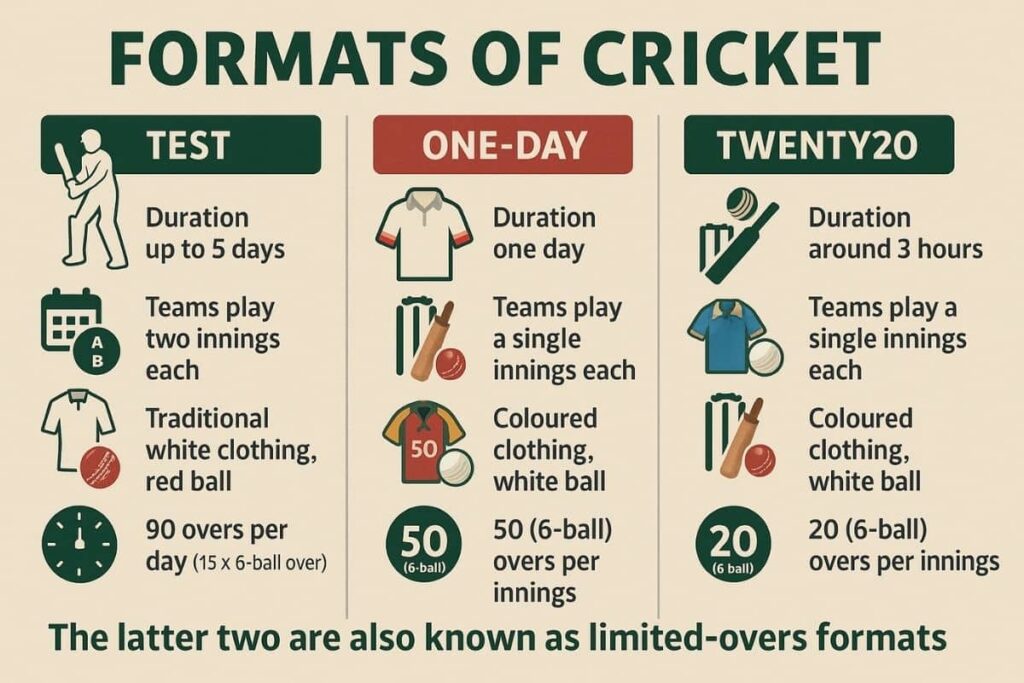
Cricket’s rich tapestry is woven from multiple formats—each striking a unique balance between tradition, strategy, and entertainment. Below, we explore the four main formats, their key characteristics.
1. Test Cricket: The Ultimate Trial of Endurance
Often called the “ultimate test” of skill and temperament, Test cricket represents the sport’s oldest and most traditional form.
Key Features
- Duration: Up to five days, with six hours of play per day divided into three sessions.
- Innings: Each side bats twice, and there are no over limits per innings.
- Attire & Equipment: Players wear white kit and use a red ball.
- Result Possibilities: A win, loss, draw, or even a tie (the rarest outcome).
Why It Matters
- Captains deploy long-term strategies around pitch deterioration, bowling rotations, and batting partnerships.
- Bowlers exploit swing and seam on fresh turf, then spinners leverage cracks and variable bounce as the match unfolds.
Learn more on Wikipedia’s “Test cricket” page or explore the latest ICC World Test Championship updates on the ICC’s official site.
2. One Day Internationals (ODIs): Balancing Patience and Pace
Introduced in 1971, ODIs brought a one-day spectacle that combined tactical depth with a defined limit on play.
Key Features
- Duration: Approximately 8 hours in a single day.
- Overs: Each team faces a maximum of 50 overs.
- Attire & Equipment: Coloured kits, white ball, and increasingly, day/night fixtures under floodlights.
- Fielding Restrictions: Powerplay overs impose limits on outfield fielders to encourage scoring.
- Result Determination: No draws—rain-affected matches use the DLS method to reset targets.
Why It Matters
- Teams craft innings in phases: cautious starts, consolidation in the middle, and an all-out slog in the final 10 overs.
- Bowlers must vary pace and line to contain run rates, while captains juggle field placements to thwart big hitters.
3. Twenty20 (T20): High-Octane Entertainment in Three Hours
Launched by the ECB in 2003, T20 cricket revolutionized the sport with its thrill-a-minute pace.
Key Features
- Duration: Roughly 3–4 hours—ideal for evening audiences.
- Overs: Each side bowls 20 overs.
- Attire & Equipment: Coloured kits and white ball; powerplays restrict fielders for the first six overs.
- Bowler Limits: No bowler may exceed 4 overs.
- Entertainment Factor: Emphasis on boundaries, improvisation, and tactical innovations like the “free hit.”
Why It Matters
- Batsmen seek strike rates north of 150, deploying inventive strokes from ball one.
- Bowlers rely on yorkers, slower balls, and wide lines to outfox batters in tight situations.
4. Emerging Formats: T10, The Hundred & Franchise Leagues
Cricket continues to evolve, spawning new experiments designed for even shorter attention spans and global appetites.
- T10 Cricket
• Ten overs per side; matches finish in 90 minutes.
• Fastest format yet—batters attack from ball one. - The Hundred
• Introduced in England in 2021: 100 balls per innings.
• Unique bowling sets (five or ten balls) and strategic time-outs. - Franchise T20 Leagues
• IPL (India), BBL (Australia), CPL (Caribbean), and more.
• Combine local talent with global stars; massive broadcast and sponsorship deals.
Each format offers a distinct flavour—from the grind-it-out chess match of Tests to the excitement of franchise T20s—yet all share cricket’s core drama of bat vs. ball. Understanding these formats not only enriches spectatorship but also guides aspiring players in choosing the style of play that suits their strengths.
V. Basic Rules of the Game 🏏
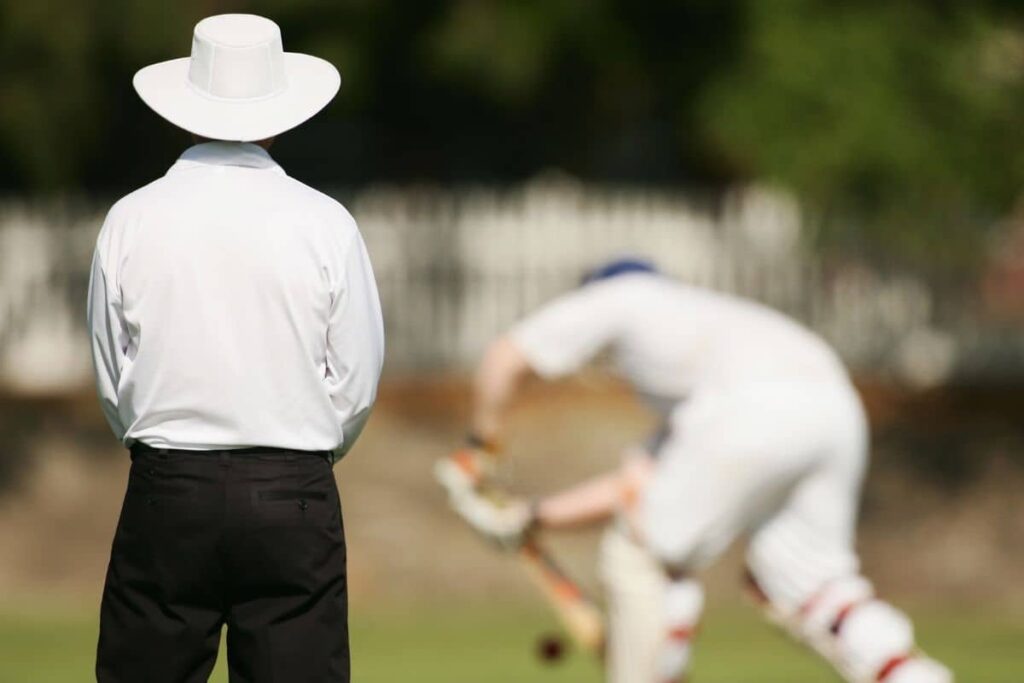
Cricket may appear complex at first glance, but its core rules are elegant and strategic. Whether you’re a newcomer or brushing up your knowledge, understanding the basics—innings, overs, scoring, dismissals, and umpiring—is essential to appreciating the game.
1. Match Structure: Innings, Overs, and Formats
A cricket match is divided into innings, where one team bats while the other bowls and fields. The number of innings and overs depends on the format:
- Test Matches: Each team bats twice (two innings each), with no over limit.
- ODIs (One Day Internationals): Each team gets 50 overs.
- T20s: Each team gets 20 overs.
An over consists of six legal deliveries bowled by one bowler. After each over, a new bowler takes over from the opposite end of the pitch.
📘 Learn more about innings and overs from the ICC’s Playing Conditions.
2. Scoring Runs
Runs are the currency of cricket. The batting team aims to score as many as possible, while the bowling team tries to restrict them.
Ways to score runs:
- Running between the wickets: When both batters successfully run to the opposite ends after hitting the ball.
- Boundaries:
• 4 runs if the ball crosses the boundary after touching the ground.
• 6 runs if it clears the boundary on the full. - Extras: Runs awarded due to errors by the bowling side, such as wides, no-balls, byes, and leg byes.
- Penalty runs: Awarded for serious infractions like ball tampering or time-wasting.
3. Modes of Dismissal
A batter can be dismissed in several ways, ending their turn at the crease. The most common methods include:
| Dismissal Type | Description |
| Bowled | Ball hits the stumps and dislodges the bails. |
| Caught | Ball is caught by a fielder before touching the ground. |
| LBW (Leg Before Wicket) | Ball hits the batter’s leg in line with the stumps and would have hit the wicket. |
| Run Out | Batter fails to reach the crease before the ball hits the stumps. |
| Stumped | Batter steps out of the crease and the wicketkeeper removes the bails. |
| Hit Wicket | Batter accidentally hits the stumps with their bat or body. |
| Obstructing the Field | Batter deliberately hinders a fielder. |
| Timed Out | New batter fails to arrive within the allowed time. |
📚 Explore all 11 dismissal types on Wikipedia’s Dismissal in Cricket.
4. Umpiring Signals and Fair Play
Umpires are the on-field judges who enforce the rules and communicate decisions using hand signals. Here are some key signals:
| Signal | Meaning |
| ☝️ Raised Finger | Out |
| ➖ One Arm Horizontal | No Ball |
| ➖➖ Both Arms Horizontal | Wide Ball |
| 🖐️ Arm Swung Across Chest | Four Runs |
| 🙌 Both Arms Raised | Six Runs |
| 👆 One Arm Raised | Bye |
| 👞 Tap on Knee | Leg Bye |
| 🔄 Circular Motion | Free Hit |
| ❌ Arms Crossed | Dead Ball |
| 📺 Rectangle Shape | Third Umpire Review |
Understanding these signals enhances your viewing experience and helps players stay informed on the field.
📖 See all umpire signals with illustrations at It’s Only Cricket.
VI. Cricket Equipment Essentials
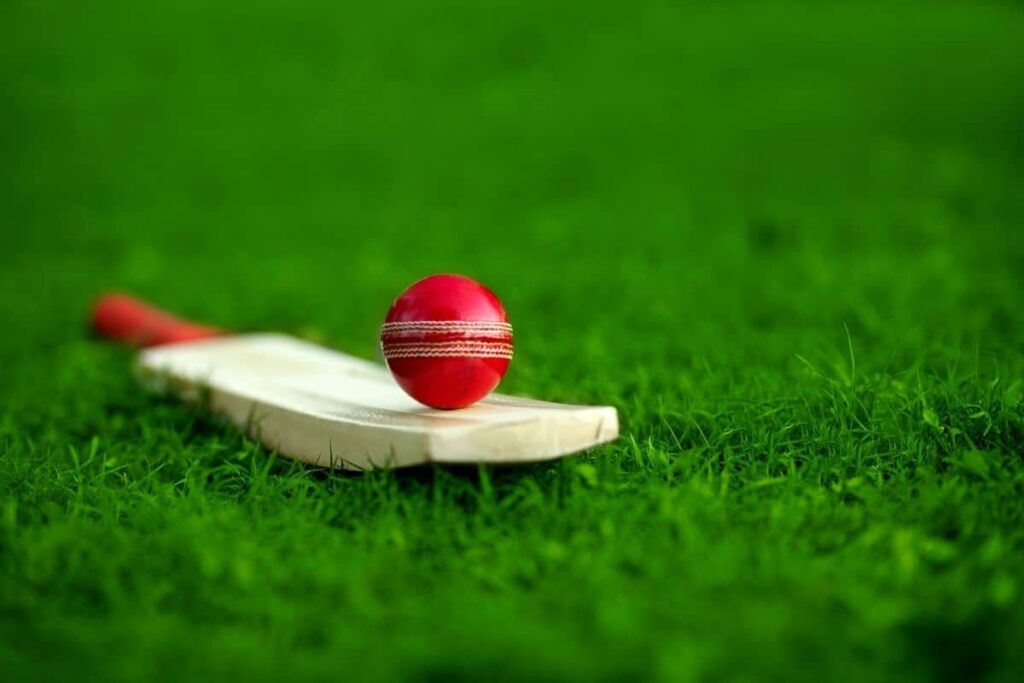
1. The Bat: Wood Types, Design, and Grip Styles
A high-performance cricket bat is typically made from English willow, prized for its lightness and ability to absorb shock, or Kashmir willow, which offers greater durability at a lower cost. Moreover, the bat’s profile—including its spine height, edge thickness, and sweet spot location—dictates power and timing, so manufacturers meticulously balance these elements for different playing styles. Additionally, modern bats feature ergonomic rubber grips in varied textures (ribbed, pyramidal) to enhance control and reduce vibration on mishits.
2. The Ball: Seam Construction, Maintenance, and Wear
A regulation cricket ball consists of four leather panels stitched together with six rows of high-tension thread, forming the pronounced seam that bowlers exploit for swing and seam movement. Furthermore, balls come in red (Tests), white (limited-overs), and pink (day-night Tests), each dye affecting visibility and wear patterns differently. To maintain its performance, fielding sides routinely polish one hemisphere using sweat or lanolin-wax polish, creating a contrast surface for aerodynamics. Over time, the ball’s seam flattens and the lacquer peels, which umpires monitor closely for replacement.
3. Protective Gear: Helmets, Pads, Gloves, and Guards
Safety equipment is non-negotiable when facing a 90 mph delivery. Helmets adhere to stringent standards (e.g., BS 7928) with steel grills and padded liners to guard against head injuries. Leg pads and gloves incorporate high-density foam and hard plastic inserts over critical bones, minimizing impact from fast-paced shots; specialized thigh guards, arm guards, and box (abdominal guard) complete the kit. Additionally, wicketkeepers wear extra-reinforced gloves and pads, while fielders close to the bat may don shin pads and helmets.
4. Clothing and Footwear: Spiked Shoes, Whites vs. Coloured Kits
Cricket apparel has evolved from heavy cotton whites to breathable, moisture-wicking fabrics that keep players cool in tropical climates. Test matches still feature the iconic all-white kit, whereas ODIs and T20s sport high-visibility-coloured jerseys with sponsor logos. Underfoot, players choose spiked shoes (metal or moulded plastic studs) for grip on turf and pitch, or rubber-soled trainers in artificial-pitch and indoor leagues to prevent damage.
5. Field Equipment: Stumps, Bails, Boundary Markers
The playing area is defined by its stumps—three wooden poles, each 28 in (71.1 cm) tall—and bails that must rest atop them until dislodged by the ball or wicketkeeper. In limited-overs games, metal-cored bails equipped with LED lights signal a clean break instantly, aiding umpires and broadcasters. Boundary markers range from bright ropes to inflatable panels, clearly demarcating scoring zones, while sightscreens behind the bowler’s arm optimize visibility against all backdrops.
VII. How to Get Started: Playing Cricket
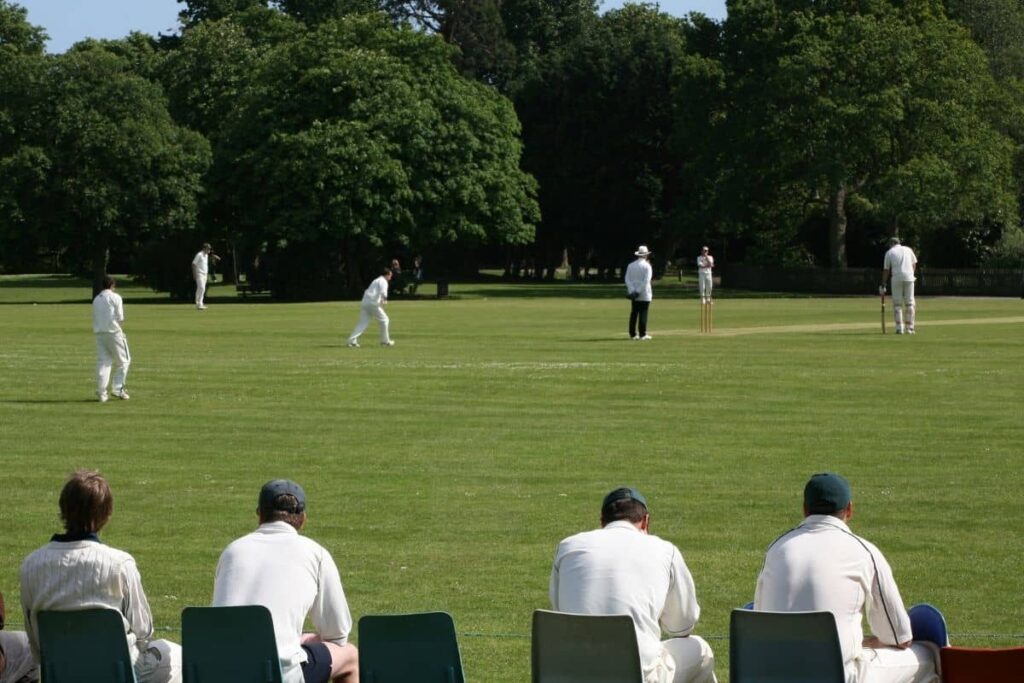
Picking up cricket for the first time can feel daunting, but with structured steps and the right resources, any beginner can dive in confidently. Below, we break down the essential phases—toss, batting, bowling, fielding, and practice routines.
1. The Toss: Choosing to Bat or Bowl First
Every game kicks off with a coin toss, where the visiting captain calls heads or tails. Winning the toss grants you a strategic choice:
- Batting first lets you set a challenging total on a fresh pitch, especially under clear skies.
- Bowling first can exploit early morning or evening conditions (swing and seam movement) and pin the opposition under scoreboard pressure.
2. Batting Fundamentals: Grip, Stance, Footwork, Shot Selection
Solid batting technique is built on four pillars:
- Grip
• Place your top hand (left for right‐handers) near the top of the handle, forming a “V” with your thumb and forefinger.
• Rest your bottom hand lightly below, allowing wrists to roll through the shot.
You can see annotated photos and drills on wikiHow’s How to Bat in Cricket. - Stance
• Stand side‐on to the bowler with feet shoulder-width apart.
• Distribute your weight evenly, knees slightly bent, bat toe resting just behind the back crease.
• Keep your head still, eyes level, and hands close to your body. - Footwork
• Move forward or back decisively—abetter footwork ensures you meet the ball under your eyes.
• For drives, stride toward the pitch of the ball; for cuts, transfer weight onto the back foot.
• Practice ladder drills and shuttle runs to build quickness. - Shot Selection
• Play with soft hands to deaden jagged deliveries; use the pace of the ball to guide it to gaps.
• Learn a basic repertoire—straight drive, cut shot, pull shot—before attempting sweep or reverse sweeps.
3. Bowling Techniques: Grip, Run-Up, Release
Whether you aim to swing the new ball or spin it on dusty tracks, mastering these bowling basics is key:
- Grip Variations
• Seam bowling: Index and middle fingers rest on either side of the seam for control and lateral movement.
• Spin bowling: Spread fingers wider across the seam; wrist position dictates off-spin or leg-spin.
Detailed finger placements and tutorials are available on wikiHow’s How to Bowl in Cricket. - Run-Up and Approach
• For pace, use a measured 8–12-pace run-up to generate momentum.
• For spin, a shorter 3–5-pace approach helps maintain balance and accuracy.
• Keep your eyes fixed on your spot at the crease to align your body. - Release Point and Follow-Through
• Aim to release the ball just after your front foot lands, with a straight arm to avoid no-balls.
• Follow through by driving your bowling shoulder down the pitch, which adds pace and dip.
4. Fielding Drills: Catching, Ground-Fielding, Throwing Accuracy
Great fielding can change a match. Start with these proven drills:
- Catch & React: Partner throws random high and low catches; focus on footwork and soft‐hand technique.
- Stop and Throw: Roll the ball at various speeds; sprint, impede the ball with a long barrier, then drive a throwback to stumps.
- Target Practice: Place a stump or cone at mid-wicket; practice underarm and overarm throws to hit the target dead-centre.
5. Practice Routines and Drills for Absolute Beginners
Consistency and variety keep practice engaging and effective:
- Tennis-ball Cricket: Use a tennis ball to build confidence—its softer bounce means less fear of injury and more time to work on technique.
- Net Sessions: Alternate 15-minute batting and bowling nets, mixing in throwdowns and spin-partner drills.
- Small-Sided Games: Play 5-a-side or pairs cricket to force quick decision-making and sharpen all skills.
By following these structured steps—understanding the toss, honing batting and bowling basics, drilling fielding techniques, and committing to smart practice—you’ll transform from a curious newcomer into a confident cricket player. So, grab that bat, lace up your spikes, and get ready to experience the game that captivates billions worldwide!
VIII. Benefits of Playing Cricket
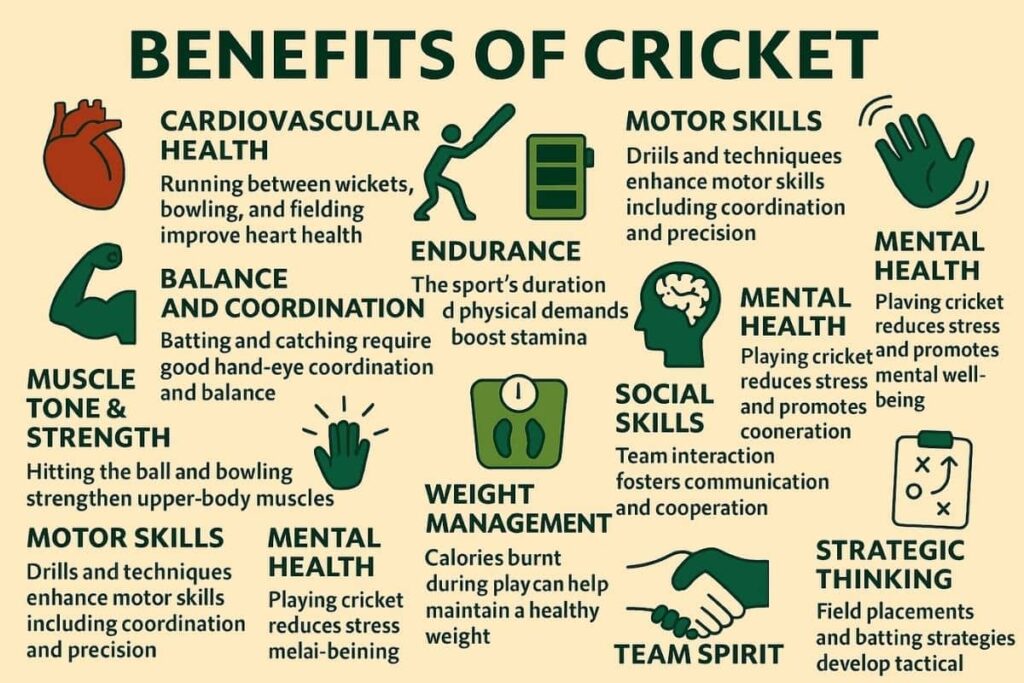
Cricket is far more than a bat-and-ball pastime. Its unique blend of endurance, skill, and teamwork delivers profound benefits across your body, mind, and social life. Below, we unpack these advantages in detail.
A. Physical Benefits
- Cardiovascular Health and Endurance
Cricket’s intermittent bursts—sprinting between wickets, chasing down a boundary, diving for a catch—pump up your heart rate and then allow brief recovery periods. Over weeks of regular play, this cycle strengthens your heart muscle, improves lung capacity, and lowers resting blood pressure. Well-documented by the Better Health Channel, even occasional cricket can boost overall cardiovascular fitness and stamina. - Muscular Strength, Tone, and Flexibility
Swinging a willow-wood bat works your core, shoulders, and forearms, while bowling engages your legs, back, and hip muscles. Fielding drills—think long-on throws or keeper crouches—further develop explosive power and joint mobility. These varied movements build lean muscle mass and improve functional strength for daily activities. - Balance, Coordination, and Agility
Every timed shot and quick reaction to a turning delivery refines hand-eye coordination and body awareness. Regular practice of forward drives, backward cuts, and diving stops promotes neuromuscular adaptation—your brain and muscles learn to fire in perfect sync. This translates into better balance, sharper reflexes, and reduced fall risk off the field. - Metabolism and Weight Management
A continuous cricket session can burn between 300–500 calories per hour, depending on intensity and format. Alternating between high-intensity efforts and rests keeps your metabolism elevated post-match, aiding fat loss and weight control. Even recreational cricket can form the cornerstone of an effective, sustainable fitness regimen. - Injury Prevention and Longevity
Improved flexibility, joint stability, and proprioception (body-position sense) reduce the likelihood of strains, sprains, and overuse injuries. Moreover, regular warm-up, cool-down, and mobility drills—integral to cricket training—promote long-term joint health and resilience against age-related declines.
B. Mental Benefits
- Stress Relief and Mood Enhancement
Engaging fully in the game shifts focus away from daily worries and triggers endorphin release—the body’s natural mood lifters. Cricket helps in alleviating anxiety and depression, making it an enjoyable, active form of stress management. - Enhanced Focus and Concentration
Whether you’re batting for hours in a Test or adapting to the rapid pace of T20, cricket demands unwavering attention to line, length, and field placement. Over time, this hones your concentration and mental endurance—skills that transfer seamlessly to work, study, and problem-solving.Split-second decision-making on the pitch sharpens cognitive agility. - Confidence, Resilience, and Self-Esteem
Setting personal milestones—a maiden fifty or a first five-wicket haul—builds self-belief and a “can-do” mindset. Recovering from a poor performance instils emotional resilience, teaching you to rebound from setbacks both on and off the field. These psychological gains support lifelong personal growth. - Strategic Thinking and Decision-Making
Cricket is chess in athletic form: captains continually reassess bowlers, field positions, and batting orders based on conditions, opposition tactics, and match situation. This nurtures analytical skills and adaptive thinking, equipping players to weigh risks and rewards swiftly—a valuable asset in any leadership or business role. - Discipline, Patience, and Mental Toughness
The time investment and routine of nets, conditioning sessions, and match play foster self-discipline and goal-setting habits. Test cricket, in particular, demands patience and mental fortitude, training players to remain composed under pressure—qualities that enhance performance in any high-stakes environment.
C. Social & Personal Development
- Teamwork and Communication
Cricket’s essence lies in coordinated effort: bowlers rely on fielders to save runs; fielders count on bowlers to build pressure. Such interdependence cultivates clear communication, trust, and collaborative problem-solving. These team skills carry into stronger workplace and community relationships. - Leadership and Accountability
Captaining a side teaches responsibility—making tactical calls, managing personalities, and owning both victories and defeats. Young cricketers often find leadership opportunities as vice-captains or senior players, developing confidence to guide and motivate others. On-field leadership fosters life-long accountability. - Camaraderie and Networking
Shared training camps, club socials, and traveling teams forge deep bonds. These friendships, often spanning decades and geographies, provide emotional support, mentorship, and professional networking both within and beyond sport. Cricket has unique power to unite diverse backgrounds through a common passion. - Time Management and Goal Setting
Balancing practice, matches, work, or study requires efficient planning and prioritization. Cricketers learn to allocate focused blocks for skill development, fitness, and recovery—skills that translate into disciplined time management in daily life. Setting measurable performance goals on the field sharpens personal goal-setting techniques off it. - Cultural Exchange and Global Community
With major tournaments like the ICC World Cup and franchise leagues in various countries, cricket connects players and fans across cultures. Tours and overseas stints expose cricketers to new customs, languages, and perspectives—broadening worldviews and forging international friendships.
Cricket’s multifaceted benefits—spanning physical fitness, mental well-being, and social growth—make it a game that enriches every aspect of life. Whether you’re lacing up spikes for the first time or captaining your club, the rewards of playing cricket extend far beyond the boundary rope.
IX. Why Cricket Is a Game-Changer for Life
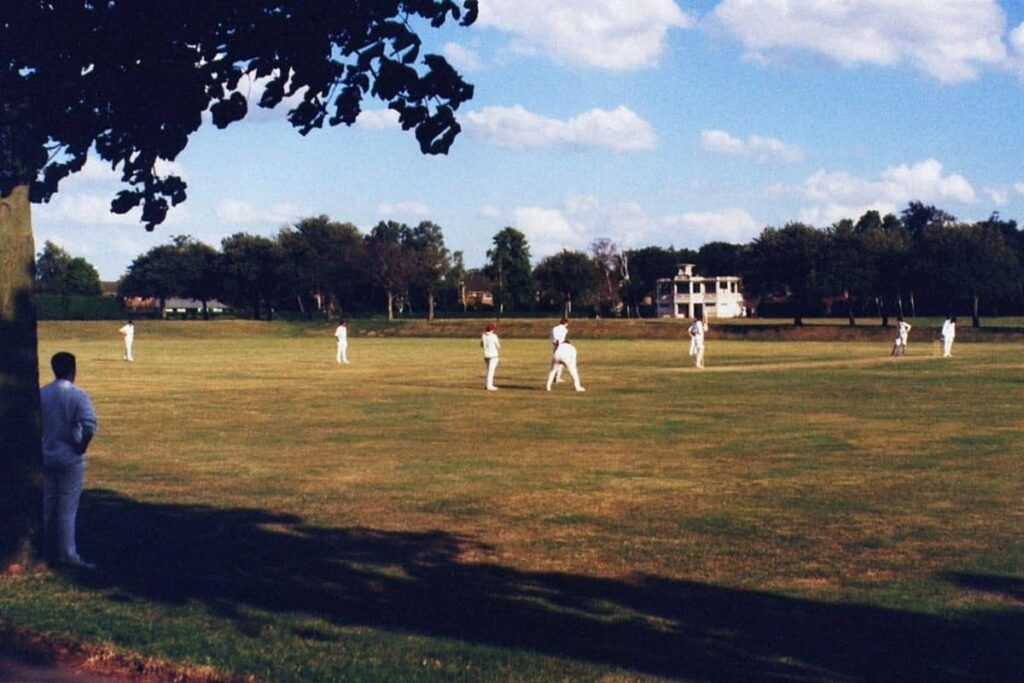
Cricket isn’t simply a sport—it’s a masterclass in life skills wrapped in leather and willow. When you step onto the field, you learn more than how to bat or bowl; you absorb resilience, humility, and the power of incremental improvement. Every practice session teaches you patience—waiting for the perfect delivery—while every match hones your ability to perform under pressure, whether that’s chasing a daunting target or defending a slim lead. These lessons translate directly into the boardroom, the classroom, and your personal pursuits, where steady perseverance and calm decision-making can be the difference between success and stagnation.
Beyond individual growth, cricket forges a deep sense of community and belonging. Clubs and local leagues become microcosms of society, bringing together people of all ages, backgrounds, and professions. The friendships you build over pre-game teas and post-match debriefs often last a lifetime, creating a support network that elevates both your social health and your career opportunities. In today’s interconnected world, playing in even a weekend league can expose you to teammates from different cultures, boosting your cultural intelligence and empathy—skills highly prized in global organizations and remote teams.
Ultimately, cricket’s greatest gift is perspective. It teaches you that—even when you’re struggling—every new over offers a fresh opportunity. You learn to celebrate small victories: a perfectly timed drive, a beauty of a delivery, a well-executed catch. Over time, these micro-successes build confidence and fuel a growth mindset that permeates every area of your life. Embracing cricket means embracing a philosophy of continual learning, teamwork, and grace under fire—qualities that redefine what “winning” means, long after the final ball is bowled.
X. Frequently Asked Questions (FAQ)
Q1: What equipment do I need to start playing cricket?
At minimum, you’ll want a bat, a set of stumps (wickets), a ball, and protective gear (helmet, pads, gloves). Beginners often start with a cricket set that includes plastic stumps and a tennis ball before upgrading to leather balls and English willow bats.
Q2: How can I learn the basic rules of cricket quickly?
Start by watching short video explainers on the key concepts—innings, overs, runs, and dismissals—then try a backyard game with friends.
Q3: What are the main differences between Test, ODI, and T20 formats?
Test matches span up to five days with two innings per side, emphasizing strategy and endurance. ODIs limit each team to 50 overs, balancing patience with aggressive batting, while T20s condense the action into 20 overs per side for high-octane entertainment.
Q4: How do I score runs in cricket?
Runs are scored by running between the wickets after hitting the ball or by clearing the boundary (4 runs if the ball bounces before the rope; 6 runs if it clears on the full). Extras—wides, no-balls, byes, and leg-byes—also add to the total when the bowler errs.
Q5: What are the most common ways a batter can be dismissed?
The five most frequent dismissals are: Bowled (ball hits stumps), Caught (fielder catches on the full), LBW (leg before wicket), Run-Out (fielder breaks the stumps during a run), and Stumped (wicketkeeper removes bails when the batter leaves the crease).
Q6: What protective gear is absolutely essential?
Helmets with steel grills (meeting BS 7928 standards), batting pads, gloves, and an abdominal guard are non-negotiable when facing pace bowling. Wicketkeepers require specialized gloves and inner gloves for extra cushioning.
Q7: How should I maintain and care for my bat and ball?
Knocking-in your new bat with a mallet and raw linseed oil builds resilience and prevents cracks. Between matches, store it in a cool, dry place and use an anti-scuff sheet. For balls, alternate polishing one hemisphere to preserve one shiny side—this aids swing bowling.
Q8: How often and what should I practice to improve quickly?
Aim for 3–4 weekly sessions, mixing net batting, bowling drills, and fielding practice. Incorporate strength and conditioning workouts—sprints, plyometrics, core training—to build fitness specific to cricket.
Q9: Is cricket good for fitness and weight management?
Absolutely. A steady mix of short sprints, aerobic running between wickets, and sessions in the field can burn up to 500 calories per hour. Additionally, the dynamic movements improve muscle tone, agility, and cardiovascular endurance.
Q10: How can I find a local cricket club or coach?
If you’re looking to get involved in cricket, finding a local club or coach is easier than you might think. Many neighborhoods have thriving cricket communities that welcome newcomers of all skill levels. Start by exploring nearby sports complexes, parks, or school grounds—these often host regular training sessions and matches. A casual conversation with fellow cricket enthusiasts or a visit to your local sports center can point you toward active clubs and certified coaches. Whether you’re just starting out or aiming to sharpen your skills, local resources offer a great way to dive into the game and build connections in the sporting world.
Q11: What is the Decision Review System (DRS) and how does it work?
In cricket, the Decision Review System (DRS) serves as a technological safeguard to ensure fairness and accuracy in umpiring decisions. When a team feels an on-field call is questionable, they can opt to review it using advanced tools like ball-tracking simulations, sound-based edge detection, and thermal imaging to assess contact points. These technologies help determine outcomes such as LBWs, catches, and other game-defining moments. To maintain strategic use, teams are granted a limited number of unsuccessful reviews—typically more in Test matches than in shorter formats—making each review a high-stakes call that can influence the flow of the game dramatically.
Q12: What does the “Spirit of Cricket” mean?
The “Spirit of Cricket” represents the deeper values that define the game beyond its rules and regulations. It highlights the importance of mutual respect between players, officials, and spectators, fostering an atmosphere of integrity and fairness on the field. Whether it’s applauding an opponent’s performance, accepting an umpire’s decision with grace, or maintaining composure in competitive moments, this ethos encourages players to uphold the honor of the sport. It’s about playing not just to win, but to embody the sportsmanship and camaraderie that make cricket a gentleman’s game at heart.

